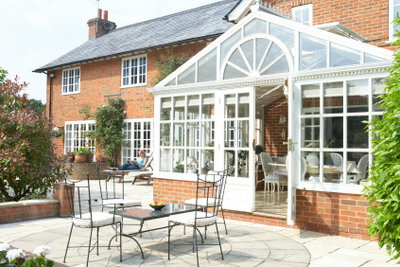Lay natural stone slabs outdoors
Granite, porphyry or slate slabs are available to give your courtyard or terrace a natural look. This is how you correctly lay such natural stone slabs outdoors.

What you need:
- Natural stone slabs
- gravel
- Vibrator
- mortar
- Concrete slab
- Rubber mallet
- Sealing slurry
- Grout
- Cement film remover
Preparation of the floor for natural stone slabs
- Thoroughly clean every surface and edge of the stone slabs with water and a brush for the later permanent bond with mortar and grout. Otherwise the slightest contamination will prevent the necessary adhesion.
- Natural stone slabs outdoors have to withstand firm ground frost in winter. Dig the installation area away from the building with a 1.5% incline. At least 80 cm, in the mountains up to 1.50 m should not be under any circumstances. Fill a bed of gravel in the trench and carefully compact it with a vibrator.
- Prepare the subsurface for your natural stone slabs with a layer of mortar at least 5 cm thick or a concrete slab at least 10 cm above the gravel bed.
Laying outdoors
- Lay the stone slabs on a bed of mortar by laying them on and knocking them on, ideally with a rubber mallet. Avoid or reduce cavities that are at risk of frost.
- Natural stone slabs in the outdoor area, which should lie on a concrete slab, are applied to a sealing slurry. You can mix these yourself or use them as a finished product from the hardware store.
- With any type of installation, avoid cavities between the natural stone slabs outdoors. Joint distances of more than 4 cm offer too much surface for frost to attack. Also use your own mixture of quartz sand and trass cement or 2-component epoxy resin from a specialist retailer for grouting.
Lay natural stone slabs on the terrace
A terrace with natural stone slabs has a special look. In addition, ...
Clean all natural stone slabs outdoors with plenty of clear, clean water as soon as the surface is pressure-resistant. Remove any remaining cement residue from the panel surface with commercially available special cleaners (cement residue remover).
How helpful do you find this article?


